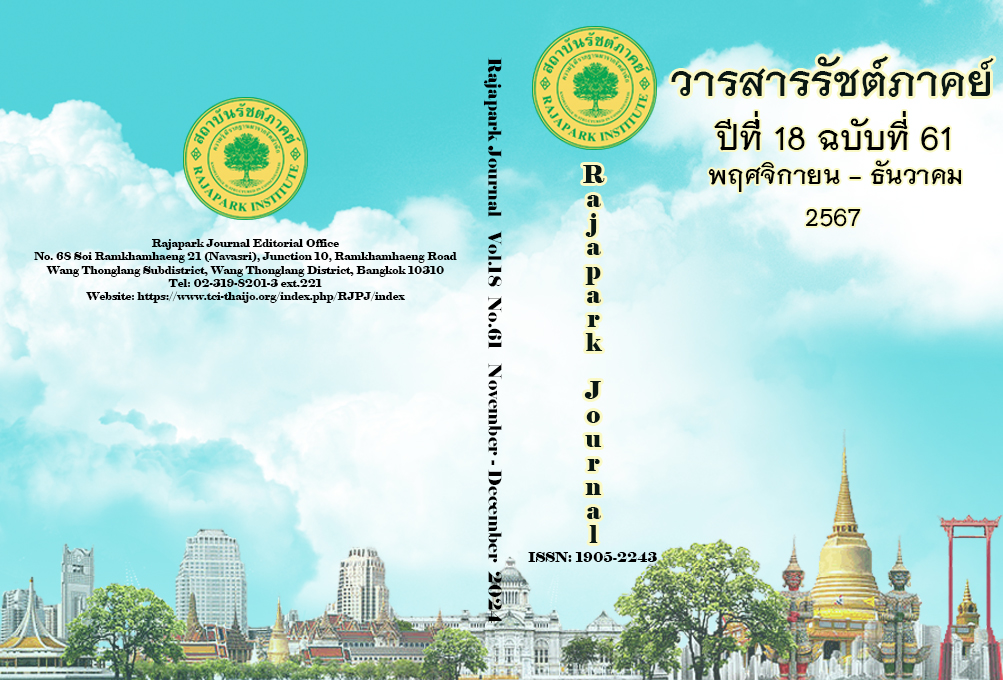The Development of Instructional Model Base on Intercultural Communication Approach to Enhance Chinese Speaking Skills of Undergraduate Students
Main Article Content
Abstract
This research focuses on developing an intercultural communication-based instructional model to enhance Chinese speaking skills. The study’s primary objectives are analyzing and exploring user needs and experiences, designing and creating the instructional model, and evaluating and reflecting on its implementation. The research findings reveal that aligning content with learners’ cultural context, providing language support, and creating an inclusive learning environment are critical factors in enhancing learners’ educational experiences. The model demonstrates the potential to foster comprehensive and relevant learning experiences. However, challenges remain, particularly in the complexity of implementation and the continuous need for content adaptation. Additionally, comparing pre- and post-instruction Chinese speaking scores indicates a statistically significant skill improvement. Reflections from learners suggest that while the model effectively promotes learning and engagement, there is still a need for additional support from instructors and stakeholders to ensure the model’s successful application.
Article Details

This work is licensed under a Creative Commons Attribution-NonCommercial-NoDerivatives 4.0 International License.
Views and opinions appearing in the Journal it is the responsibility of the author of the article, and does not constitute the view and responsibility of the editorial team.
References
Banks, J. A. (2015). Cultural diversity and education: Foundations, curriculum, and teaching. Routledge.
Briguglio, C., & Smith, R. (2012). Perceptions of Chinese students in an Australian university: are we meeting their needs? Asia Pacific Journal of Education, 32(1), 17–33. https://doi.org/10.1080/02188791.2012.655237
Burnaby, B., & Sun, Y. (1989). Chinese teachers’ views of western language teaching: Context informs Paradigms. TESOL Quarterly, 23(2), 219. https://doi.org/10.2307/3587334
Byram, M. (1997). Teaching and assessing intercultural communicative competence. Multilingual Matters.
Chen, G., & Starosta, W. J. (1996). Intercultural communication competence: A synthesis. Annals of the International Communication Association, 19(1), 353– 383. https://doi.org/10.1080/23808985.1996.11678935
Cheng, J. K. (2015). Enhancing the Chinese writing skills of non-Chinese speaking students. SpringerPlus, 4(S2). https://doi.org/10.1186/2193-1801-4-s2-o1
Chuphon, K. (2021). Pragmatic failures in intercultural communication of Chinese speakers of Thai as a foreign language. Journal of Humanities and Social Sciences, Ubon Ratchathani Rajabhat University, 12(1), 157-170. https://so01.tci-thaijo.org/index.php/humanjubru/article/view/244186
Deng, J. Y., & Kunbunjan, W. (2019). Perspectives of Chinese language instructor on Thai students’ problems with 4 Chinese language learning skills: A case study of students majoring in Chinese studies at Eastern Asia University. EAU Heritage Journal Social
Sciences and Humanities, 9(2), 19-25. https://so01.tci-thaijo.org/index.php/EAUHJSocSci/article/view/193990
Fantini, A. E. (2000). A Central Concern: Developing Intercultural Competence. SIT Occasional Papers Series (1). School for International Training.
Goulandris, N. (2003). Dyslexia in different Languages: Cross-Linguistic Comparisons. In Whurr Publishers eBooks.
Guba, E. G., & Lincoln, Y. S. (1989). Fourth generation evaluation. SAGE.
Hofstede, G. (1986). Cultural differences in teaching and learning. International Journal of Intercultural Relations, 10(3), 301–320. https://doi.org/10.1016/0147-1767(86)90015-5
Houser, J. (2008) Precision, reliability, and validity: Essential elements of measurement in nursing research. Journal for Specialists in Pediatric Nursing, 13, 297-299. https://doi.org/10.1111/j.1744-6155.2008.00171.x
Ip, W. H. (2016). Enhancing intercultural communication in teaching Chinese as a foreign language: An action research study [Unplublished Doctoral dissertation, The Hong Kong Polytechnic University]. https://theses.lib.polyu.edu.hk/bitstream/200/8720/1/b29254681.pdf
Joyce, B. R., & Weil, M. (1980). Models of teaching. Prentice-Hall.
Joyce, B., Weil, M., & Calhoun, E. (2015). Models of teaching (9th ed.). Pearson.
Khemmanee, T. (2016). The art of teaching: Effective teaching models and techniques (21st ed.). Chulalongkorn University.
Kürüm, E. Y. (2016). Teaching speaking skills. Annals of the University of Oradea: Economic Science, 25(1), 264–273.
Liddicoat, A. J., Papademetre, L., Scarino, A., & Kohler, M. (2003). Report on intercultural language learning. Commonwealth Department of Education, Science and Training.
Liu, S., Yang, L., Zhang, C., Xiang, Y., Liu, Z., Hu, S., & Zhang, B. (2020). Online mental health services in China during the COVID-19 outbreak. The Lancet Psychiatry, 7(4), e17–e18. https://doi.org/10.1016/s2215-0366(20)30077-8
Maddikunta, P. K. R., Pham, Q., B, P., Deepa, N., Dev, K., Gadekallu, T. R., Ruby, R., & Liyanage, M. (2022). Industry 5.0: A survey on enabling technologies and potential applications. Journal of Industrial Information Integration, 26, 100257. https://doi.org/10.1016/j.jii.2021.100257
McKenney, S., & Reeves, T. C. (2018). Conducting educational design research. In Routledge eBooks.
McKenney, S., & Reeves, T. C. (2019). Conducting educational design research. (2nd ed.). Routledge.
Nunan, D. (1989). Designing Tasks for the Communicative Classroom. Cambridge: Cambridge University Press.
Song, H. (2014). Cross-cultural Communication and Foreign Language Teaching. In Proceedings of the 2014 International Conference on Education Technology and Social Science. https://www.atlantis-press.com/proceedings/icetss-14/14707
Srikoon, S., Khamput, C., & Punsrigate, K. (2024). Effects of STEMEN teaching models on mathematical literacy and mathematical problem-solving. Malaysian Journal of Learning and Instruction, 21(2), 79–115. https://doi.org/10.32890/mjli2024.21.2.4
Stickler, U., & Shi, L. (2013). Supporting Chinese speaking skills online. System, 41(1), 50–69. https://doi.org/10.1016/j.system.2012.12.001
Supawadee, P. (2023). Assessment of Chinese language learning in language education institutions. Journal of Educational Studies, 23(1), 45-60.
Thongthangyai, P., & Kaoein, A. (2023). A study of problems and needs in enhancing Chinese speaking ability for undergraduate students. Journal of Education, Silpakorn University, 21(1), 265-277.
Torky, S. A. E. F. (2006). The Effectiveness of a Task-Based Instruction Program in Developing the English Language Speaking Skills of Secondary Stage Students. Cairo: Ain Shams University. https://www.scirp.org/reference/referencespapers?referenceid=2635874
Tran, Q. T., & Sheepo, S. (2016, May). An intercultural communicative language teaching model for EFL learners. In Ho Chi Minh City Open University 4th TESOL Conference 2016 (pp. 27).
Zhang, Q. (2014). Misinterpretations of Intercultural Communication among Chinese Foreign Language Educators. Theory and Practice in Language Studies, 4(5). https://doi.org/10.4304/tpls.4.5.917-922


